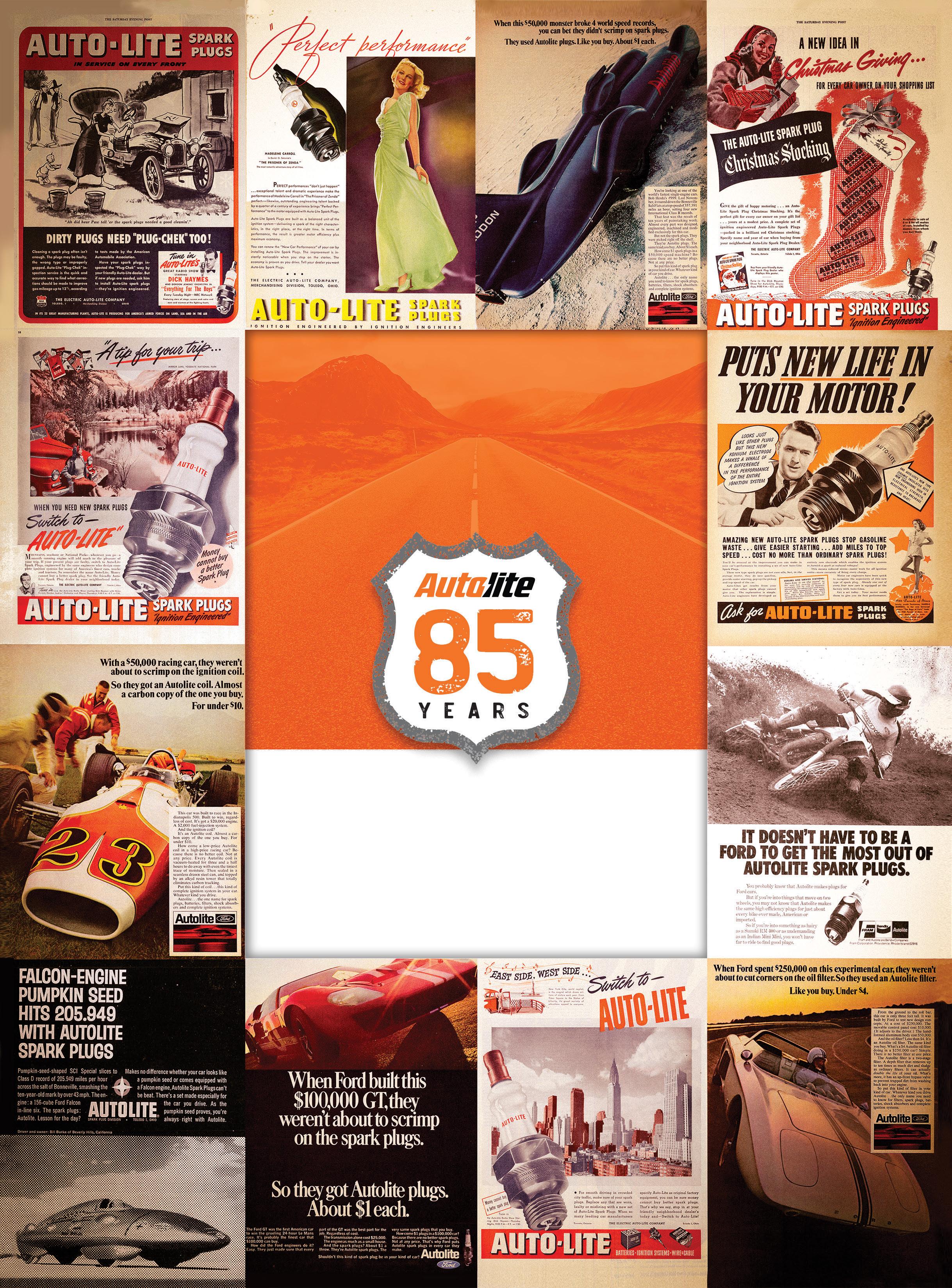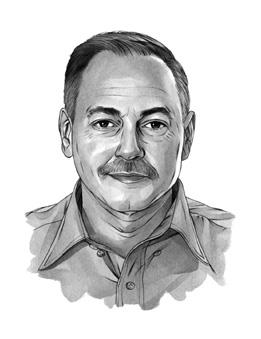
23 minute read
STRAIGHT TALK

from Ratchet+Wrench - June 2021
by EndeavorBusinessMedia-VehicleRepairGroup
Columns STRAIGHT TALK
Joe Marconi
THE TUNNEL VISION TRAP
Will you allow technology to make your business obsolete?
There was once a time when you needed a device called a “camera” to take a photo. This camera was loaded with what was called “film.” You took a series of photos by pushing a button and the desired images were imprinted onto the film. The film was then removed and mailed to a company (most likely Kodak) or you took the film to a drug store to have it developed (where they most likely used a process developed by Kodak). When you received the film, those photos were printed on Kodak paper. I’m having a little fun here, but bear with me. The story of Kodak is an important lesson for us all.
The Kodak Company was founded in 1888 by George Eastman. Eastman disrupted the industry by putting the ability to take photos in the hands of the average consumer. His strategy was to sell inexpensive cameras, which would use his film. The profits would be made on the film purchase, the film-developing process, and all of the related materials needed to produce the finished photos.
Kodak dominated the film and camera industry in the 20th century. In 1969, Kodak produced the camera that was used by astronauts on the Apollo 11 moon mission. The first-ever photo of Earth taken from deep space was taken by equipment manufactured by Kodak. By 1996, Kodak was rated as the most valuable business in the world with revenue hitting $16 billion. That same year, Kodak was valued at $31 billion. In spite of all its success and fortune, on Jan. 19, 2012, Kodak filed for bankruptcy.
How could Kodak fail? Kodak didn’t know what business it was in. Kodak thought it was in the film business and stuck firmly to its old strategies. By the early 2000s, the digital camera became the dominant player in photography, and we all know how the cell phone has taken over. While Kodak tried to reinvent itself in the early 2000s, the company never seriously invested in new technology. Kodak’s biggest mistake was that it never realized its greatest asset was not film, the camera, or any of its physical attributes. Kodak’s greatest asset was its customers.
What happened to Kodak should send a strong message. If we look at our own industry, we are in the midst of perhaps the biggest revolution since the internal combustion engine car replaced the horse and buggy. However, unlike Kodak, I am confident that with an open mind, the typical independent repair shop will make the transition into the future.
Understand what business you’re truly in. You may think you’re in the business of repairing cars. That’s what you do. It’s not the reason why you do what you do. You’re in the business of taking care of people and building strong relationships within your community. It’s crucial that you realize this, because no matter what, your customers will be driving in the future. If you gain their trust and loyalty, they will continue to think of you.
Don’t get tunnel vision on what you are doing now. Keep investing in your future and embrace change. Bump up your training budget and keep everyone in your shop updated on the latest technology. And don’t worry about training someone only to have them leave you. We have all heard the expression, “There’s only one thing worse than training someone and having them quit on you. And that’s, not training them and having them stay!”
The future will require a larger investment in technology. Which means profits must go up in order to have the financial horsepower to operate the shop of the future. It will also be essential that you understand the numbers of your business. There is no way you will be able to transition unless you are profitable.
Finally, you will need to employ the best people to remain competitive, which means you’ll need to attract the best of the best by creating an amazing work environment and creating an attractive pay program. Putting all this aside, it will be your roots in your community, your brand, and the customers you have built strong relationships with that will continue to be your greatest asset.
Joe Marconi has more than three decades of experience in the automotive repair industry. He is the owner of Osceola Garage in Baldwin Place, N.Y., a business development coach for Elite Worldwide and co-founder of
autoshopowner.com.
j.marconi@eliteworldwide.com
ratchetandwrench.com/marconi
Brand Builder
Caitlin Monson (center left) took the lead to develop The Detroit Garage model as well as a full team of marketing and sales support.
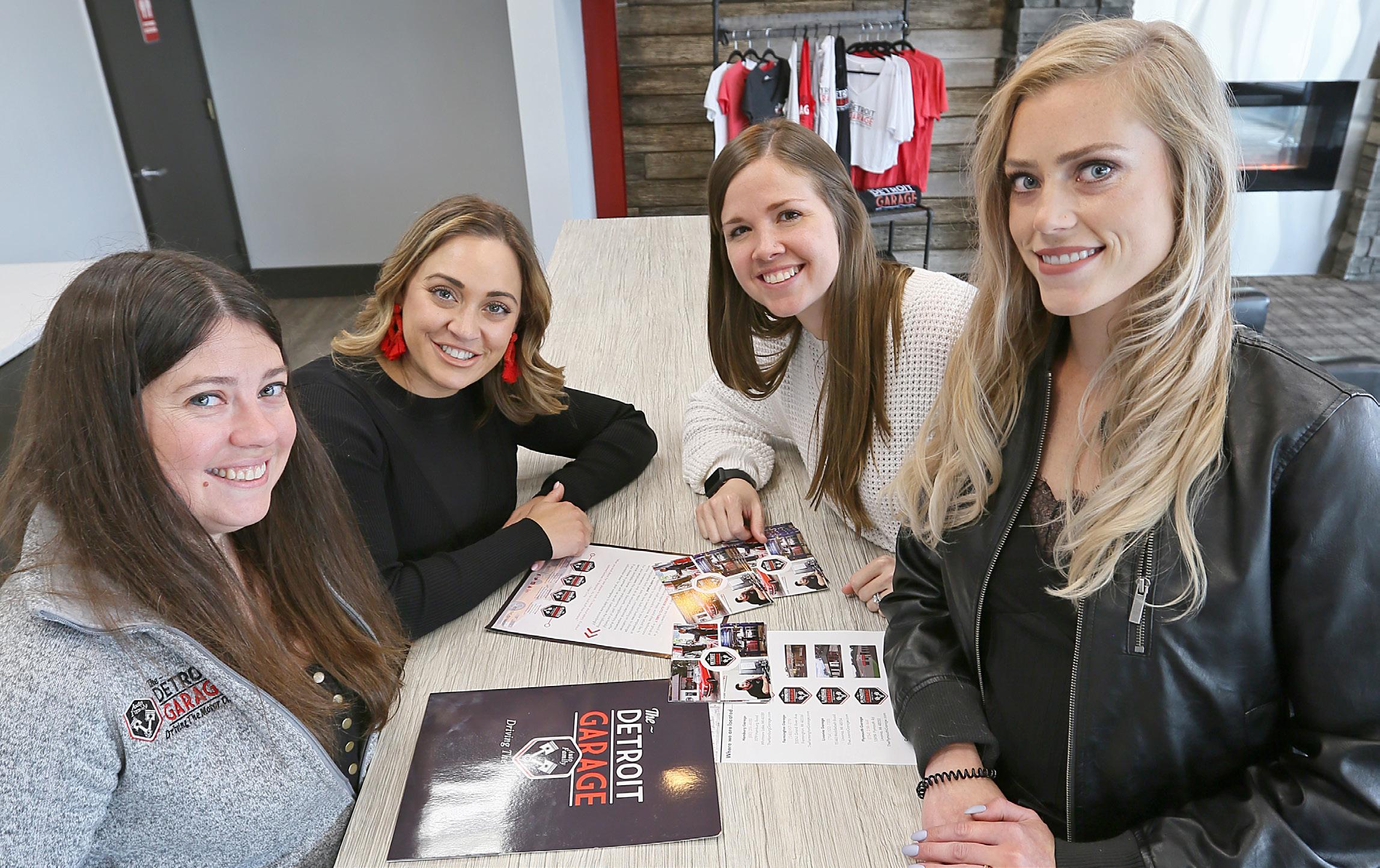
MASTERFUL MARKETING
A marketing plan pivot inspired a hometown brand that’s paving the way for future growth
BY MEGAN GOSCH PHOTOGRAPHY BY ANNE LIEW
For Hamburg, Mich., local, Sarah Brown, a drop-in at The Hamburg Garage is a true visit to her local repair shop—an outpost just up the road where she knows the team and they know her.
She can chat with the shop’s advisor about the town’s big plan to buy the local golf course over a cup of coffee, or send out a few emails from the lobby’s high-top tables while she waits, and connect with a tech about the work done before heading out.
Months later, when she hears a strange sound under the hood 40 miles from home, a call to the Hamburg shop will help get her squared away with an emergency appointment at the nearby Farmington Garage. The Farmington team’s already been briefed, reviewed her vehicle history and is ready to hop in where the Hamburg team left off by the time she arrives—a stressful scenario turned seamless with the creation of The Detroit Garage, a Michigan-based family of auto repair shops that’s been years in the making. “That [scenario] sounds idealistic— but it happens all the time and service like that is 100 percent what we set out to achieve,” says director of sales and marketing Caitlin Monson.
But the creation of a full-fledged repair group wasn’t always the goal. The Detroit Garage was actually created through the brainstorming of a complete marketing makeover.
Ratchet+Wrench checked in with The Detroit Garage team to learn how they’ve rolled out a fresh marketing model that’s paving the way for future growth, and consulted with marketing pros for insights on the key elements for success when evolving your brand.
Rethink the road ahead.
Back in 2017, Andy Massoll was at a crossroads.
He’d recently bought out his business partner, was now the owner of three Michigan repair shops, and was already eyeing a brighter future.
Massoll was considering ventures into detailing work and fleet services as well as the launch of additional shops, but wasn’t sure how he’d market the new entities. At the time the only unifying element between his three independent shops was APQ Auto, a limited liability company (LLC) name only used on formal paperwork and tax forms.
That’s when Monson posed a few critical questions. “I started asking, what is APQ? What does it stand for? You’ve got these three shops, but what do you want to do with them? Where are you trying to take the business and how does that line up with the way you’re running things now?”
It was a pivotal moment to take stock and consider how the old and new could merge when it came to marketing the bigger picture, she says.
NOTES FROM THE PROS: Clarify your “why.”
“A larger vision should be behind any big marketing move you make. A lot of shops will change their name or logo because they want something new, but boredom isn’t a reason to change something you’ve been building for years.”
—Carrie-Lynn Rodenberg
Concept a clear vision.
After months of discussion and brainstorming, Monson made a pitch to change the formal company name and build it into a full-fledged brand that could act as an umbrella uniting Massoll’s existing shops and any future businesses that took shape down the line.
The parent company could help market each shop, and each shop could maintain its unique identity, but also offer customers the support of a larger operation to cover any of its own service gaps. Potential fleet sales would have the power of multiple shops to back the service and Massoll could add new entities to the business as he went.
“The idea became ‘let’s create a brand that’s recognizable, and harnesses the power of a fully connected network, but leaves space for hometown connection and individuality because ‘true hometown repair’ had always been part of the motto,” says Monson.
Later that year, a part-time Monson came on board in full, an executive team was created to manage marketing, sales, and coordination between the newly unified shops, and APQ Auto formally became The Detroit Garage.
The Detroit Garage name itself was also strategically picked—not just for its local pride, but for its potential as an easily adaptable formula.
“The goal wasn’t exactly to go out and build an empire, but the name does drive home that local connection we were looking for in a way that we could easily replicate and potentially even expand with to a city like Nashville or Denver,” says Monson. “Right now we’re focused on the Detroit market, but it gives us space to stretch into new markets. We’re not boxed in.”
Since introducing The Detroit Garage umbrella, the company has officially launched fleet and detailing businesses and four new repair shops with no signs of slowing down.
NOTES FROM THE PROS: Keep naming simple.
“If customers don’t see your name and think, ‘Oh, auto repair; got it,’ you’re limiting your potential. Anything that’s hard to pronounce, uses funky spelling, or doesn’t make sense off the bat will confuse and lose customers.”
—Carrie-Lynn Rodenberg
Build on what works.
More Than a Name While streamlining the company’s marketing efforts Monson has been careful to protect each shop’s true differentiator: community connection.
MEET THE PROS:
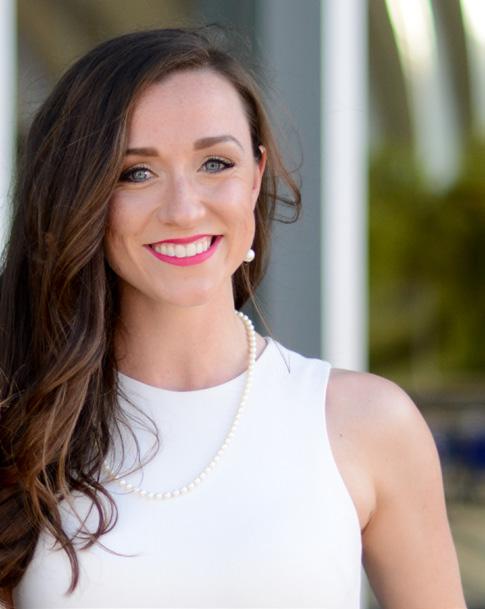
Carrie-Lynn Rodenberg is the founder and owner of Turnkey Marketing, a marketing director service for auto repair shops that works to increase car count through a full suite of marketing services, from full strategy planning and implementation to managing custom social media and direct mail campaigns.
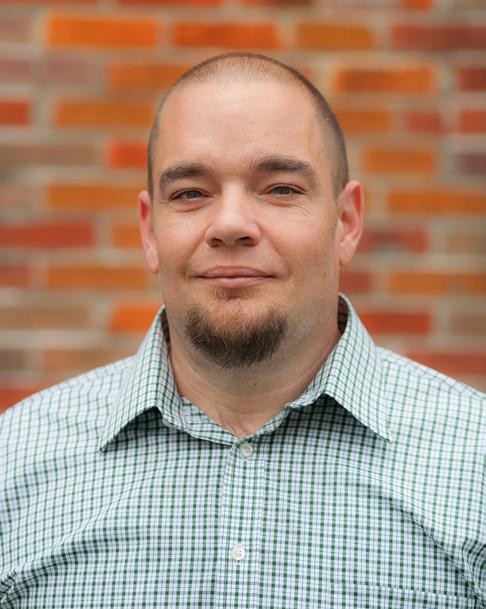
Brian Walker is a former shop owner and the co-owner of Shop Marketing Pros, a full service marketing agency specializing in the independent automotive aftermarket helping shops with everything from web management and SEO to email marketing and pay-per-click campaigns.
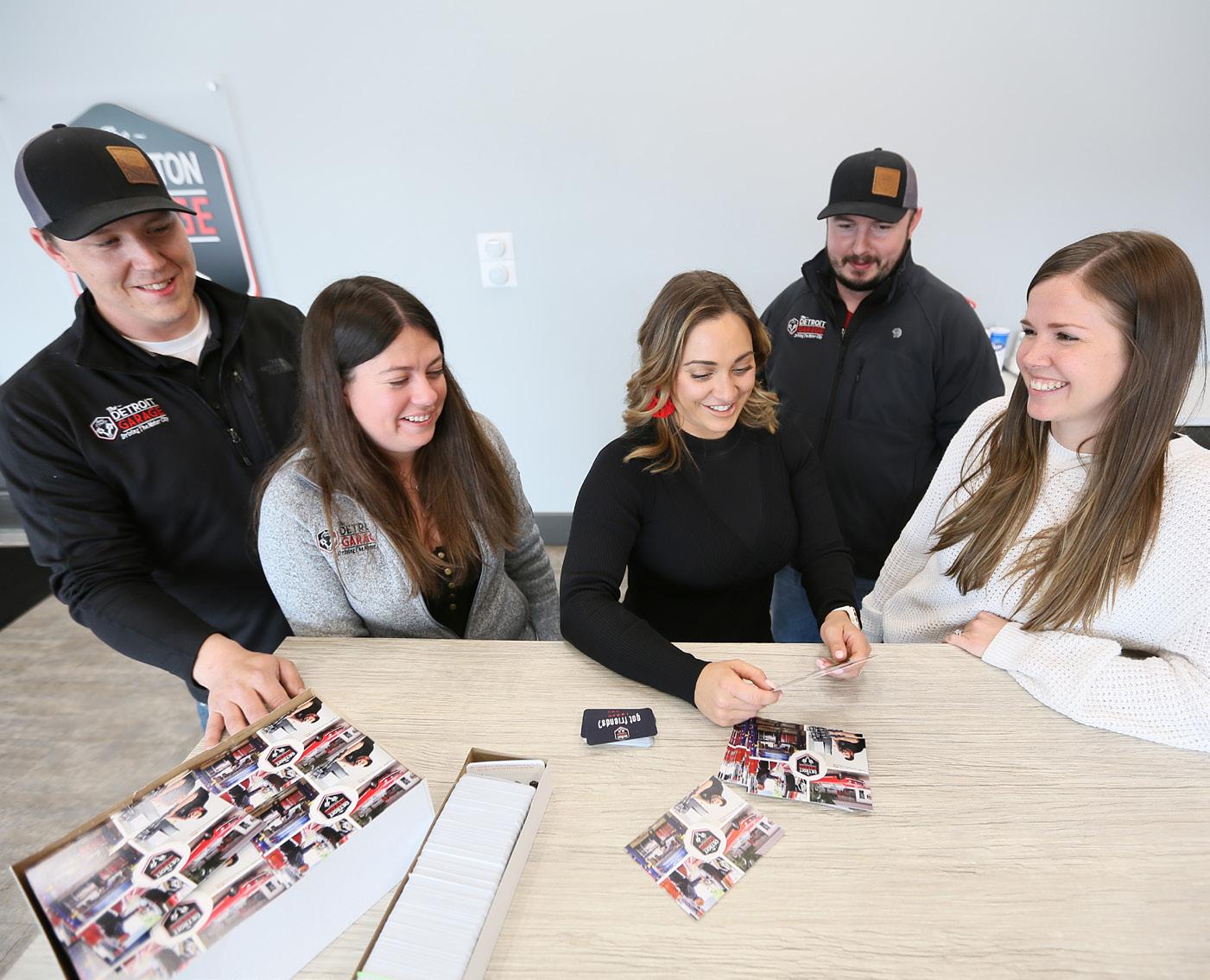
Carefully Curated
From decor to direct mail campaigns, Caitlin Monson and her team keep each shop’s branding efforts in sync.
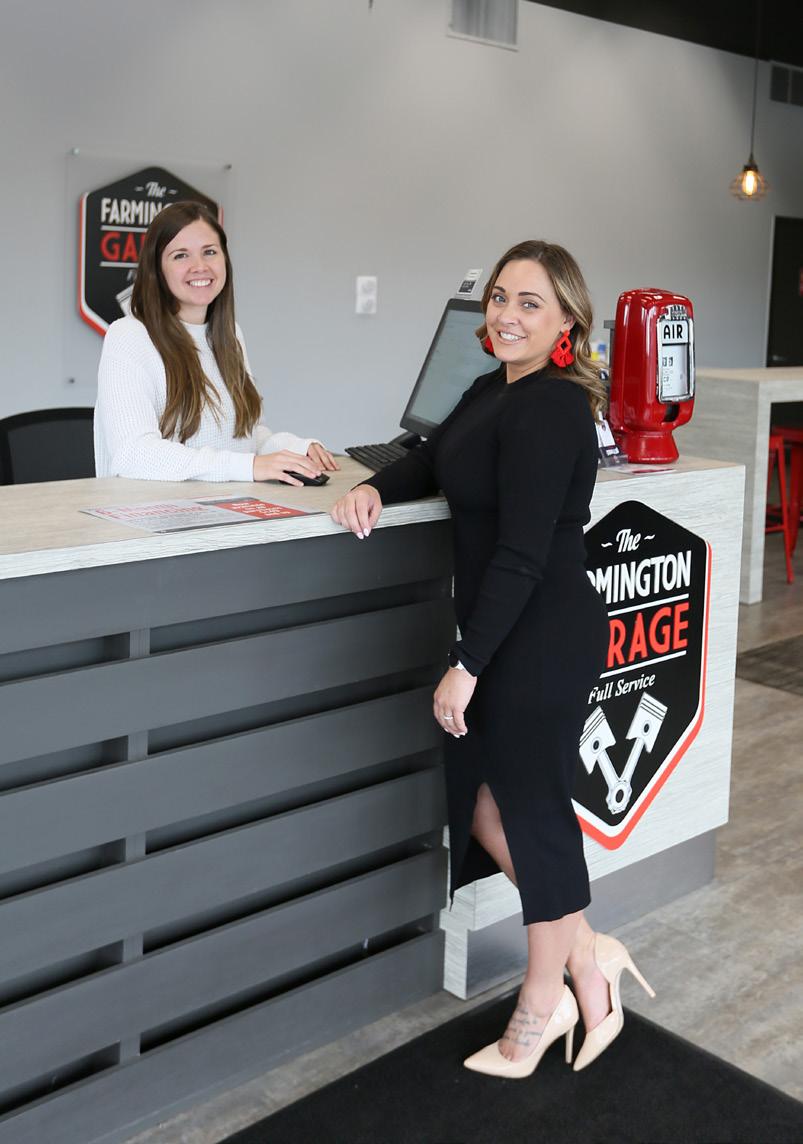
“The concept sounds formulaic, but the key is allowing each shop to maintain its local identity as a hometown asset,” she says.
Each shop is involved with its local Chamber of Commerce and helps support hometown groups and events like high school sports teams and community farmers markets, but “we found at those first shops—The Farmington Garage and The Hamburg Garage—driving home that local tie right in the name really solidified that community identity, so we’ve emulated across the board,” Monson says.
Since launching The Detroit Garage concept, each of the company’s shops has followed the format, first with the launch of The Livonia Garage in 2018, then The Plymouth Garage in 2019, and most recently with The Canton Garage in 2020.
“If it’s working well, why mess with it?” she says. The same goes for the group’s logos.
A Visual Impact
Before The Detroit Garage model took shape, Massoll had recently rebranded The Farmington and Hamburg Garages and had new logos made in the process. Each featured a black shield bearing the look of a traditional coat of arms with two joint pistons beneath each shop’s name and a distinct pop of red.
“When we began building the parent company concept, my question was ‘what are the things that are already most recognizable? For me it was the shield and the color scheme, so that’s what I carried through.”
Each new entity under The Detroit Garage umbrella uses a similar logo design to create consistency as well as a subtle tie to the family’s other shops.
“If someone is seeing The Livonia Garage logo or The Canton Garage logo, that’s creating a level of familiarity and brand association for the entire group.”
The Outlier
One notable exception? Curt’s Service.
The Oak Park shop, which was launched in 1981 and is still co-owned and run by Massoll’s father, has not been rebranded to match The Detroit Garage.
The reason? A rebrand to match the company’s other shops would eliminate its community tie. Through its 40 years in business, the shop has built its reputation in the Oak Park community and Massoll’s father continues to be a large part of the shop’s identity and success—something a rebrand could ultimately undo.
“It might look good on paper for The Detroit Garage as a parent company, but on the individual level it would go against everything we’re trying to achieve with those community connections, and ultimately that’s what the umbrella model helps with— keeping these unique businesses connected.”
NOTES FROM THE PROS: Don’t trash your most valuable asset.
“For a shop that’s got a strong identity and become a real pillar in the community, that’s a name worth keeping. You don’t want to wipe out that community clout 30 years in the making overnight.”
—Brian Walker
Set clear a clear path for promotion.
With the creation of The Detroit Garage model, Monson has created a clear model to address where and how the parent company is marketed in coordination with each individual shop.
Online
Monson created a Detroit Garage website to serve as a digital homebase for the repair shop family, but each shop has its own individual URL as well.
The Detroit Garage site greets visitors with “We Are The Detroit Garage. Welcome to Our Auto Family,” while renderings and links to each shop helps demonstrate the company’s scope. Visitors can read
reviews aggregated from each shop’s website, providing a look at the customer experience across the board, and options to find a location or make an appointment right from the homepage drives further traffic back to each shop’s individual site.
Each shop’s individual website has been formatted to match The Detroit Garage’s, but is customized with its own logo and and photo. Each site also features a shopspecific photo gallery and customer reviews, while individual Facebook pages also create a space to share each team’s personality and connect with the local community.
IRL
Monson has also intentionally represented The Detroit Garage family in each shop’s physical location.
Each shop’s unique name and logo is promoted on its signage and direct mail features the photos of the respective local team, but the staff across all Detroit Garage outposts sport the parent company’s merch.
“We’re not shying away from that parent company identity. If we’re promoting the power of that repair family connection online, we need to keep that presence consistent in person as well,” says Monson. “All of our guys wear Detroit Garage hats, uniforms, buttons, T-shirts, it’s on our business cards. It’s also reflected in the way we’re communicating with customers and potential clients.” When talking with clients, members of The Farmington Garage team say they work at The Farmington Garage but work for The Detroit Garage. “It’s a mindset shift in how you convey that relationship to your customer base.”
NOTES FROM THE PROS: Craft a cohesive message.
“The messages you’re sending across your website, mailers, social media, and in person experience all need to tell the same story. The more consistent your message, the better it will perform.”
—Brian Walker
Bring your brand to life.
Monson has also curated a streamlined physical look at each Detroit Garage shop to complement and reinforce the company’s branding efforts and set a standard for the customer experience.
She likens the model to a boutique restaurant group; each eatery might have its own menu and reflect its own style but diners are likely to appreciate a common aesthetic and amenities across locations.
“We wanted to carry through that marriage of retro and new school elements that we’ve worked into the branding, and logos, and official colors,” she says.
Pops of the red-orange from the company’s logos are incorporated in everything from outdoor awnings and garage doors to customer lounge bar stools, while whitewash siding and pallet and faux-brick walls have all become mainstays.
“No two shops look exactly the same, we’re working with the unique characteristics of each space, but in the same way anyone visiting the websites will see a throughline across each and a visit to the shops themselves should feel familiar.”
Monson’s also set customer amenities like Wi-Fi, plenty of outlets, and an array of refreshments as non-negotiables. A month-long renovation at The Canton Garage, one of the newest locations, was needed to create a customer lobby that meets Detroit Garage standards.
NOTES FROM THE PROS: Make a full commitment.
“When you make a brand change, you have to commit and streamline across every part of the business. You may have just bought new business cards or uniforms, but it’s got to go. That change should be reflected anywhere customers hear about you, see you, or interact with you.”
—Carrie-Lynn Rodenberg
“Now that we’ve set those customer expectations, each space really needs to fit the bill before we put our name on it. A customer should be able to visit any location and relax for a full day if needed.”
The company’s signature shop look, like it’s naming convention, has also been strategized for easy adaptation and expansion.
“That streamlined look was designed to be classic, something we won’t have to update in the next five or 10 years, so we’ve boiled it down to a science we can carry out at each new location as we grow.”
Inside the Consumer Mind
With UpSwell
TAKE ADVANTAGE OF THE FACTORS CUSTOMERS MOST CONSIDER WHEN CHOOSING A REPAIR SHOP
No one will ever really ever know why a customer chose to go to the repair shop down the road instead of yours. But what we can do is analyze the top factors customers look at when choosing their repair shop. UpSwell Marketing has performed two comprehensive surveys to uncover this relevant data.
Market Your Shop’s Value
Unsurprisingly, 65 percent of survey participants stated “value and pricing” as a deciding factor when choosing a repair shop. But while price is important, Jeff Snyder, executive marketing consultant at UpSwell, states that it’s far more beneficial for shops to market their value.
He recommends owners focus their marketing on their shop’s unique benefits, including use of a customer shuttle or loyalty program. This specific value-based marketing targets consumers focused on level of service.
Encourage Positive Reviews
Following “value and pricing”, 60 percent of participants identified “good reviews and reputation” as a top deciding factor in choosing their repair shop.
“When a consumer must decide between two shops that are equidistant from them, they will inevitably choose the shop with the highest ratings and the most ratings,” Snyder says.
Target the Right Audience
Two other top deciding factors for consumers choosing a repair shop are “convenience” (47 percent) and “brand specialist” (27 percent). As a way to take advantage of these decision factors, owners must specifically pinpoint who their direct mail and digital marketing is targeted to. "With direct mail, we always run an analysis on where their customers currently are to figure out the best areas to target,” Snyder says. For more tips with UpSwell Marketing on how to take advantage of the consumer survey data, visit ratchetandwrench. com for the full, unabridged article. To learn more about UpSwell, visit upswellmarketing.com/ratchetwrench or call 888.838.3779.
MANIFEST YOUR VISION
AN UNCONVENTIONAL BUSINESS PLAN HAS PUSHED FIX IT FORWARD TO GROW
BY PAUL HODOWANIC
Most people don’t have that ‘a-ha’ moment you see in the movies, one that changes the direction of someone’s life.
Matt Carlson did. He even remembers the moment vividly.
He was sitting at his desk at Microsoft, where he served as a programmer, fixing a typo on an error message screen in an obscure piece of software that “nobody would ever see.”
That’s when his phone rang. On the other end was a woman desperate for the help of Carlson’s passion project, a nonprofit he founded and ran out of his farm with a handful of volunteers called Fix It Forward Ministry, which fixed cars for those who couldn’t afford repairs.
She needed her Dodge Durango fixed—ASAP.
Talking with the woman, Carlson realized she needed it much faster than his current six-week backlog could provide. She had just been informed her abuser was being released from jail in two weeks, and although a crisis center was helping her and her kids relocate, it was impossible without transportation.
“That’s when I realized I couldn’t do the software thing anymore, when I had this opportunity to really help people,” Carlson says.
His mind was made up: He quit his job at Microsoft, which he’d held for 15 years, and helped the woman and her family relocate quickly. He’s continued that work, helping members of his local community in Moorhead, Minn., ever since.
He’s coupled the nonprofit organization, Fix it Forward Ministry, with a for-profit repair shop, Fix It Forward Auto Care. During regular business hours, the Fix It Forward Auto Care facility operates like any other repair shop. At night the space becomes a valuable community resource, as volunteers
FIX IT FORWARD AUTO CARE — MOORHEAD
OWNERS: Matthew and Kristi Carlson
LOCATION: Moorhead, Minn.
SHOP SIZE: 7,200 square feet
STAFF SIZE: 8
LIFTS: 8
AVERAGE MONTHLY CAR COUNT: 310
MANIFEST YOUR VISION
Non-profit
complete free repairs and fix up donated cars to give away for free.
A True Win-Win
Carlson began the nonprofit, Fix It Forward Ministry, in 2015. The goal was simply to find those in the community that were being hindered because of unreliable transportation and provide the support they needed to be self-sufficient.
Up until Carlson left Microsoft, all operations were happening from his personal shop at his farm. But once Carlson left to run the nonprofit full time, the demand started to increase at an unsustainable rate with the resources they had.
Carlson’s original idea was to find other shops in the area that would be willing to house the cars and spread out the work across multiple locations. He found that other shops were willing to volunteer to repair the vehicles, but not at their own shops. He looked at buying an existing shop, but with such a unique business model of his own, Carlson worried the shift would be detrimental to the business.
So, Carlson started his own shop, Fix It Forward Auto Care, in 2018. During the day, he’d run it like any other repair business. Then after hours, the nonprofit would have a space to work for free, with ultimate convenience for Carlson.
Other than providing the space, the repair shop does not support the nonprofit financially in any way. Volunteer technicians come from other repair shops in the area and all parts and other nonprofit expenses are funded by community donations. Excess profits from the for-profit get reinvested back into the repair business. Carlson says this model is used in other industries, but he has not seen it used in the auto industry.
Carlson estimates the nonprofit utilizes 100 unique volunteers every year. In its lifespan, the organization has given away 270 cars and repaired another 600.
The repair shop also sees benefits from the nonprofit, Carlson says. Customers want to bring their business to the shop to help support its
FIX IT FORWARD AUTO CARE — FARGO
OWNERS: Matthew and Kristi Carlson
LOCATION: Fargo, N.D.
SHOP SIZE: 8,125 square feet
STAFF SIZE: 7
LIFTS: 10
AVERAGE MONTHLY CAR COUNT: 300
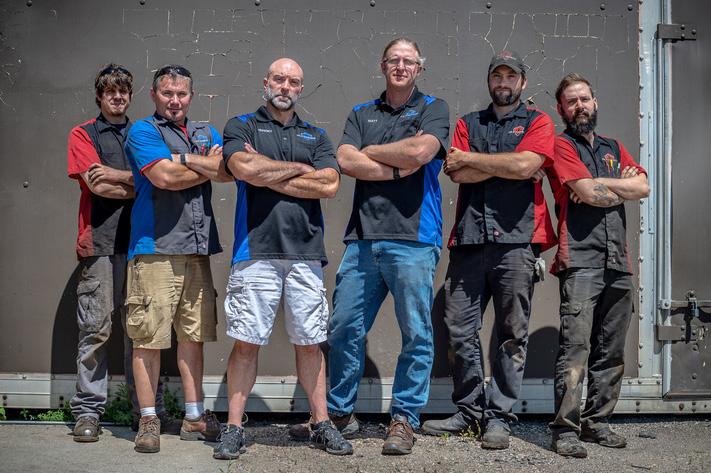
mission. They also inherently trust his team, Carlson believes.
“Trust is a big issue in the auto repair industry, but why would we lie to a customer about their car and then turn around and give away free repairs and cars?” he says, adding that the mission attracts both quality customers and quality technicians who are keen on making a difference.
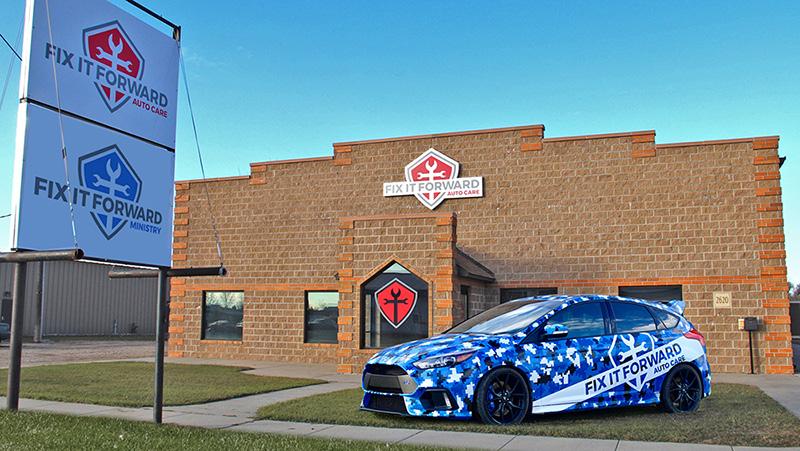
A Well-rounded Approach
What makes the nonprofit different from almost any other organization that fixes cars or gives away cars for free, is that they don’t deal directly with the customer, Carlson says.
Instead of taking in requests directly from the general public, the nonprofit only accepts jobs from referrals from their partner organizations. This avoids the tedious and time consuming task of vetting every request to make sure the need is real and someone isn’t just trying to take advantage of a free car or repair.
The nonprofit works with over 40 different agencies including local homeless shelters, jail systems, housing agencies, job training organizations and mental health facilities. All of the organizations have case managers, who will refer their clients to the facility. If the nonprofit were to field requests on its own, Carlson estimates he’d have to staff dozens of case managers to meet the overwhelming demand.
“We aren’t not specifically helping people, so much as we’re helping these organizations help people,” Carlson says. “If somebody can’t afford to fix their car, that’s not the root of their problem. There’s something else going on that got them into a situation where their car isn’t reliable and they can’t afford to fix it.”
What Carlson finds is that these organizations do everything they can to help fix the large issues, whether that’s getting them proper counseling, job training, or housing. But without transportation they can’t get a job and without the job they don’t have money to spend on transportation. That’s where the nonprofit steps in.
“There’s nothing else in our community to help with transportation,” Carlson says, noting the local bus system isn’t operational 24 hours a day or on Sundays and often doesn’t go to the industrial parks that many work in. “Transportation is the No. 1 barrier for these organizations’ clients to becoming self-sufficient.”
Standout Strategy
Matt Carlson’s (center right) less than traditional business model is designed to make a full community impact.
Slow and Steady
When Carlson began the nonprofit, he never expected the amount of the support he received or that there would be as big of a need as there has been.
But now that it has become evident that the for-profit can be fiscally viable and the nonprofit can be socially responsible, Carlson is ready to expand.
They’ve already added an additional repair shop just 13 miles away in Fargo, N.D.
Carlson’s goal is to grow as fast as reasonably possible while not outgrowing themselves. He believes a franchise model would work best in other communities, that would operate a repair shop during regular business hours and then follow Fix It Forward Ministry’s vision by aiding the nonprofit after hours.
Carlson isn’t setting a hard deadline or timeline on his expansion, but feels that a new shop every couple years is realistic. He is eager to prove the business model will work in other communities. He believes the results that the first shop has produced more than prove that.
